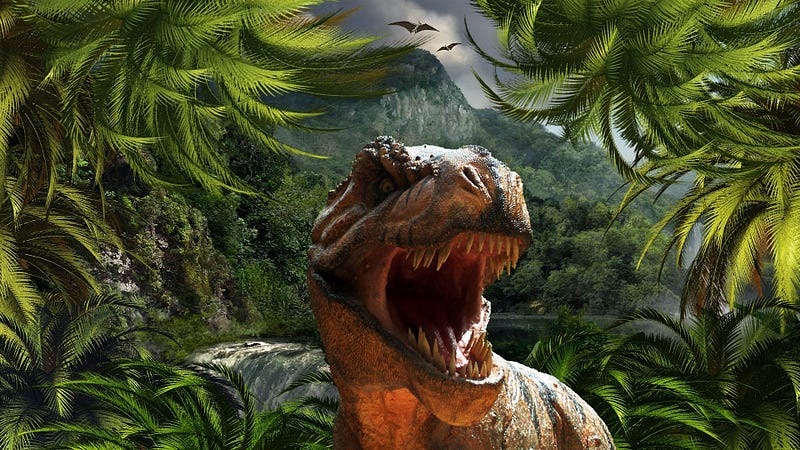The Cataclysm That Marked the End of the Dinosaurs' Era
Written on
Chapter 1: The Mass Extinction Event
Sixty-six million years ago, the world witnessed a catastrophic event that led to the extinction of numerous species, including the last flightless dinosaurs. Along with them, the massive mosasaurs and plesiosaurs that ruled the oceans, as well as the pterosaurs soaring the skies, met their demise. The oceans' plankton, essential to the food chain, suffered immensely, leading to the disappearance of various marine families such as brachiopods, sea sponges, and ammonites. Shark populations dwindled, and much of the terrestrial vegetation perished. In total, over half of the Earth's species vanished.
The cause of this mass extinction during the late Cretaceous and early Tertiary remains a mystery. Scientists continue to investigate why certain species, including many mammals, turtles, crocodiles, frogs, and salamanders, managed to survive. Remarkably, birds, snails, clams, starfish, and sea urchins also persisted, as did resilient plant species that could endure extreme conditions.
Theories on Dinosaur Extinction
Researchers primarily consider two theories to explain the extinction event of the Cretaceous period. The first posits that a celestial object, such as an asteroid or comet, struck Earth. The second theory suggests that a significant surge in volcanic activity contributed to the mass extinction.
In both scenarios, dust would have shrouded the sky, blocking sunlight and inhibiting photosynthesis. Once this dust settled, greenhouse gases trapped in the atmosphere could have caused a dramatic rise in temperatures, leading to the extinction of many organisms that had survived the initial darkness.
Impact of an Asteroid or Comet
Evidence supporting the impact theory emerged from the discovery of a geological layer rich in iridium, a rare element on Earth but commonly found in meteorites. This layer, present globally, indicates that iridium was dispersed when a celestial body collided with our planet.
Additionally, the Chicxulub crater, located off the Yucatán Peninsula in Mexico, was formed around 66 million years ago and is believed to be linked to this extinction event. Many scientists argue that the environmental repercussions of such an impact may have played a significant role in the dinosaurs' extinction.

Volcanic Eruptions
Conversely, Earth's interior, a source of magma, also contains iridium. Some researchers propose that extensive volcanic eruptions occurred during this time, forming vast lava fields known as traps in India, covering an area of 500,000 square kilometers with layers up to 2 kilometers thick. This volcanic activity, coinciding with the extinction period, could have also released iridium globally and emitted dust and greenhouse gases that blocked sunlight.
Both theories present compelling evidence, leading some scientists to believe that a combination of both celestial impacts and volcanic activity contributed to the extinction. Others suggest that gradual climate change and fluctuating sea levels might have played a vital role. Regardless of the cause, this event marked the end for the tyrannosaurs and ushered in a new era for mammals, which began to diversify and adapt to various habitats.
Chapter 2: The Final Days of the Dinosaurs
To understand the last moments of the dinosaurs, imagine a Mesozoic dawn on the Yucatán Peninsula, filled with sunlight illuminating coastal marshes and lush coniferous forests. The Gulf of Mexico buzzed with life while a massive asteroid hurtled towards Earth at an astonishing speed of 64,000 km/h, briefly outshining the sun before making impact.
The explosion created a crater over 185 kilometers wide, vaporizing vast amounts of rock. This cataclysmic event triggered a series of disasters that ultimately led to the extinction of approximately 80% of life on Earth, including most dinosaurs.
Research in the Chicxulub Crater
British scientists working on an oil rig in the Gulf of Mexico have gathered samples from the outer ring of the Chicxulub crater, where geological rebounding occurred shortly after the impact. Their studies aim to reveal insights into the extraordinary phenomena that unfolded that day.
Utilizing a "consequence calculator" developed by geophysicists, researchers can simulate various scenarios based on the asteroid's size and speed. Joanna Morgan, a lead scientist on the Chicxulub project, explains how users can adjust details to see how effects change with distance from the impact site.
This video explores the catastrophic impact of the asteroid that led to the extinction of the dinosaurs, providing insights into the theories surrounding this historical event.
Effects of the Impact
Within nine seconds of the impact, the intense thermal radiation would ignite vegetation, resulting in a fiery landscape. Soon after, a tsunami would occur, with waves rising to heights of 4.5 kilometers shortly after the impact, eventually traveling vast distances inland.
The subsequent earthquake, measuring 10.1 on the Richter scale, would be the strongest recorded in history. As Rick Aster, a seismology professor, notes, the seismic activity would surpass all cumulative earthquakes of the previous 160 years.
Eight minutes post-impact, debris ejected into the atmosphere would begin to fall, blanketing the scorching land with ash and gravel. The sky would darken, displaying a haunting spectacle of shooting stars as debris re-entered the atmosphere, creating a glow that could only be imagined.
The aftermath would lead to an extended period of darkness, lasting from days to potentially years, as the ash and debris enveloped the Earth, forever altering the planet's climate and ecosystems.

The second video titled "Mosasaur Shark Attack - Reign of the Dinosaurs" examines the reign of these formidable sea creatures and the catastrophic events that led to their extinction.
This video delves into the life of mosasaurs during the age of dinosaurs and the circumstances surrounding their sudden disappearance from our planet.
The world may never fully understand the intricacies of the extinction event, but ongoing research and discovery continue to shed light on this monumental chapter of Earth's history.